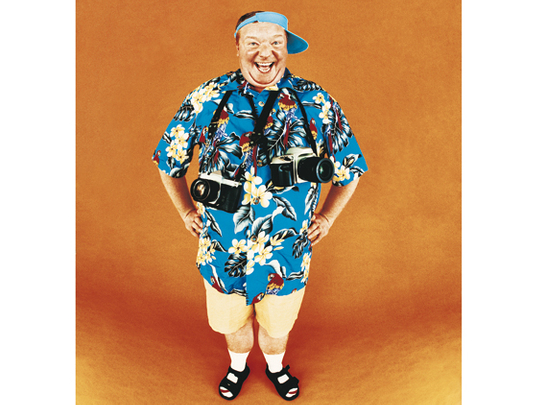
I wonder what Ellen Rakieten and Anne Coyle would have to say about American musician Billy Joel crooning away, "What's the matter with the clothes I'm wearing" in his hit single It's Still Rock and Roll to Me?
"Tsk, tsk", probably. The 1980 Billboard chart-topper was his ode to wide ties, old tab collars, cheap sneakers and bright orange pants.
US-based authors Rakieten and Coyle are a product of the Noughties and of the social matrix set against image consultants, life coaches and PhotoShop. A man in bright orange pants? Ew. They would - and, arguably, so would most women - hightail in the opposite direction.Their book, Undateable, is a guide to helping men "fix things" that women are put off by. They've drawn up a list of fashion faux pas and inappropriate behaviour, labelling these with ratings like ‘red flag' for innocent mistakes and ‘storm cloud' for a sense of unease.
Flipping through the chapters, I look at photographs of everyday men dressed as sartorial caveats. Easy to laugh at and dismiss, but lurking behind the high-waist dad jeans and mesh suits is a truth that goes beyond the risible or fault-finding visual statements: image.
You're probably thinking, ‘How shallow'. Or something along the lines of, ‘Don't judge a book by its cover'. Which naturally makes me think of the movie Shallow Hal, where Hal is a superficial man fixated on physical, not inner, beauty. Only after he is hypnotised into seeing women beyond their physical appearance does he begin to appreciate a woman's inner qualities.
But in everyday life, there is no hypnosis to make us overlook a person's appearance. Shallow or not, first impressions matter. Even research, specifically by the University of Washington in Seattle, nods its scientific head, stating that it takes less than 20 seconds for a woman to judge a man by his attire.
High-value impressions
Unfortunately, people navigate through life based on first impressions, say the authors. Coyle is an award-winning copywriter, and president and owner of Anne Coyle Interiors, a nationally acclaimed interior design firm in the US. Rakieten is the president of Ellen Rakieten Entertainment and was the creator, developer, writer and producer of The Oprah Winfrey Show for 23 years. She recently partnered with Jerry Seinfeld to create The Marriage Ref for NBC.
Both agree that first impressions are important. Coyle says, "When you meet a man [for the first time], you don't know him. If he isn't aesthetically pleasing, you may assume what is inside the package isn't much either."
The authors deliver valuable "insider" information, in the hope that every man will get a copy and use it as a field guide. And I can't help myself thinking that their attempt is a way to peddle yet another Men are from Mars, Women are from Venus analogy, dressing theirs up with the parodying reasoning behind: clothes ‘breaketh' the man.
Compared with men, women seemingly tick all the right boxes. Think about it. Girls grow up embracing their inner princesses (courtesy of Barbie) and boys are left to embrace anything they want.
When older, women try harder to make a good impression, often starving themselves to look thin and wearing shoes (no heel is too high) they can barely walk in. Above all, they practise glamour: a word that has come to represent self-assertion.
Men? They don't have anything like that kind of pressure. Going by the book, men seem to be pilloried for inappropriate dressing as well as unacceptable behaviour. Coyle says that there are some really, really nice, funny guys out there with no clue. So why do men fail so miserably at making a good impression?
Coyle believes, among other reasons, men get things wrong because women are taught at a very young age that beauty and looking good is a way to be successful. "By nature, men aren't as concerned with or committed to looking good. Traditionally, women have been admired for their beauty; men have been valued for their strength and independence. It's how we're wired. Think of Cleopatra and her great beauty. She had to do nothing but lie on a barge on the Nile and look fantastic to be powerful. The men at the time were out fighting wars." Coyle also speaks of a "community of opinions" among women. She says, "Women tend to communicate with each other and try to reach the ‘right' answer. Men don't have that. Unlike women, they don't sit around and talk about fashion or their ‘look' with each other," she says.
At this point, I beg to differ, quoting the theory behind the groundbreaking Dove ad campaign of real beauty. Isn't it time we stopped looking at airbrushed images? Coyle agrees, saying, "We should, but we are a culture where aspirations are high. We're never satisfied with the flawed ‘what is', but yearn for the perfect ‘what could be'. It's human nature."
Still, the fuss over first impressions isn't entirely warranted. Dr Gian Gonzaga's academic laboratory eHarmony Labs, affiliated with the University of Southern California, reports that the things that are important for making a long-term relationship successful are not the things that attract you to someone in the first place. According to him there are 29 dimensions of compatibility including appearance, intellect, spirituality and emotional health.
In the book, however, the authors place a high value on appearance. If appearance is merely one aspect of making a good impression, then why the heavy-handed emphasis?
To this Coyle says, "We know it is the ‘inside' that counts, but if you [men] can spruce up the outside, why wouldn't you? We're just saying, if men can easily tweak a few mistakes they unknowingly make, why wouldn't they want to fix that?"
List of offences: 311
An interesting number shows up as the subtitle of Undateable. The number 311 is quantifiable in the context of offences as much as it is qualifiable in classification. Coyle explains, "The number [311] is the non-emergency help telephone number in the US, and we felt that this book fell into that category. Not a life-threatening issue, but a problem that needed our assistance."
Humour aside, the list isn't drawn from apocryphal sources. Rather, it has examples based on the authors' experiences and observations as well as the opinions of hundreds of women around the US.
In the book, they make further categorisation (remember ‘red flag' for innocent mistakes and ‘storm cloud' for unease?) of wardrobe infractions. These weren't based on empirical findings, but "on the amount of shock with which the transgression was reported and the amount of repulsion".
A few culpable items listed include mandals (sandals worn with socks); novelty belt buckles; high-waisted dad jeans; tube socks; polo shirt with a ‘popped' collar; acid-wash jeans; crocodile skin shoes; cause bracelets; and pleated shorts.
Dressing is a question of culture, isn't it? For instance, novelty belt buckles or Birkenstocks may be en vogue in some parts of the world, but terribly dated in others. Almost providing the disclaimer to their book, Coyle says, "Absolutely. While cowboy boots with a suit will fly in Dallas, they will not go over well in NYC. The fashion violations in the book are speaking to the general population. There may be an exception in certain parts of the world."
Incidentally, Coyle prefers men who don't wear holiday sweaters, novelty belt buckles or Dockers.
Behavioural no-nos
According to the authors, what aman says is just as important as what he wears. For example, they purport that the use of certain phrases like ‘booyah', or talking in the third person or in baby talk can hijack a good impression, even if it comes from a dapper man.
In the book, they relate cases of inappropriate behaviour. They cite examples of men who make tasteless statements to excuse themselves to go to the washroom, stash away ketchup sachets, refuse to tip the waiter, or yell out "You da man" - usually accompanied by an awkward high five. These examples may give the impression that the authors are pontificating, but they believe that these "help, not humiliate".
A few statements men make, says Coyle, are vulgar and clueless. She speaks of a phenomenon in the US called ‘bro speak', referring to pointless phrases used incessantly by men who are uncomfortable with their own personalities.
"An example is the guy who says, ‘That's what I'm talking about', when the waitress delivers his burger. Such behaviour is immature and concerning. It is much more serious [than bad dressing] because being disrespectful is ingrained in someone's character," she says.
Thus far, the authors have stressed on dressing and behaviour. Can a man redeem himself by making sure he manages at least one part of makinga good impression?
For instance, even if he shows up in mandals and talks in the third person, can he redeem himself by being charmingly courteous and opening the door for the woman?
The authors firmly believe so. Coyle says, "The most important is behaviour. A man should be respectful and decent. He should be interested in what someone has to say, he should possess a good sense of humour… these are the core qualities. If a man lacks these, he will falter no matter how great he looks."
What will men make of the book?
Will men take this book seriously? After all, it is written by women. Coyle thinks this genderised fact is the very reason men should take it seriously. "This is what women really say about men to their friends. What guy wouldn't want to get his handson this?! I would buy this book if it were written by a man, geared towards women. Who would know better what women think about men than a woman?"
That said, by her own admission, Coyle says, "[The book] is a humorous observation of the male species which will correct the faux pas that stop them from impressing women. Hopefully, when men buy the book, their questions will be answered. We want men to step it up; put their best foot forward," adding that their efforts will beworth their while if they can influence just one man.
On a serious note, do men care about where their trouser turn-up ends or where their waistline begins? It seems highly implausible that a man would ask, "What did I do wrong?" in the context of making a good impression.
I mean, look at Mick Jagger in his tights or Tina Turner in her miniskirt. Like them, several tick the boxes of inappropriate dressing, and yet they aren't judged for their clothes, but admired for their assertive and independent lifestyle.
Coyle says there are those who are supremely confident and can wear whatever they want (read abominable outfits) and get away with it. "But these people are a rare breed. For the rest of us, we need to stay within the lines. Not fair, but true."
The book concludes that there is a true gentleman lurking beneath every pair of ugly grey sweatpants. Coyle says, "Clothing can be easily changed. All you need is a little guidance and a credit card. If someone is confident and has a fantastic personality, ask him to go shopping."
15 worst wardrobe errors men make
Jorts (a cross between jeans and shorts)
Japris (Capri jeans)
Wearing a mobile phone on the belt
Walking shoes
Socks with sandals
Wearing athletic jerseys and sports gear when you are not playing sport
Too-short shorts
Speedos
Hawaiian shirts
Big, bad boxy polyester tops
Baseball caps worn backwards
Mesh shirts and vests
Short-sleeved shirts
Dad jeans (high waists)
Pale blue jeans
Food for thought
Where men do as they please, women are proven to moderate their behaviour to make themselves more "attractive". Or at least that is what Meredith Young from McMaster University in Ontario found after studying eating habits.
"When women sat with men they ate rabbit food or other meals of significantly lower caloric value thanin all-women groups,"she says.
Men don't carry the same burden. Is it the demands on women that drive them to act thus while men feel free to tuck into whatever they like?
Coyle says, "There is a very defined vision of what it is to be beautiful and feminine. Being this is absolutely at the top of the list. So a woman may communicate to a man that she understands that requirement by eating ‘rabbit food'. Also, to be feminine is to show restraint and elegance, so tearing into a big steak may come across as gluttonous, which we subconsciously know is unattractive."








